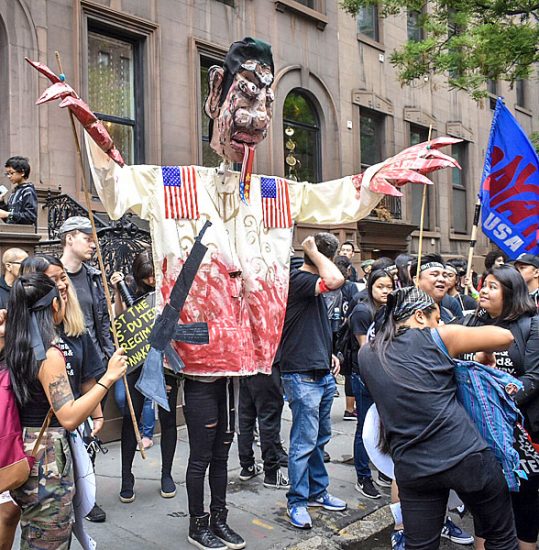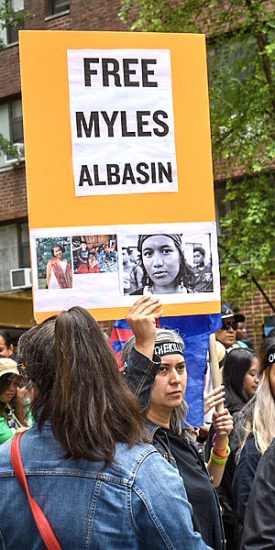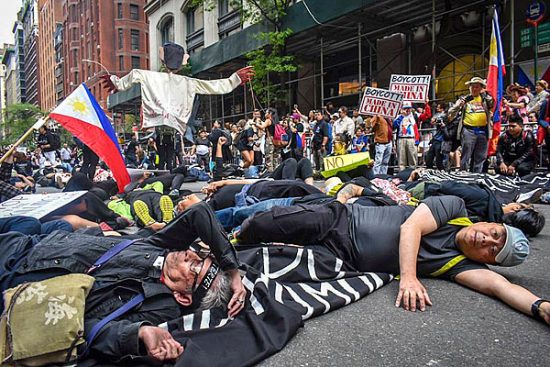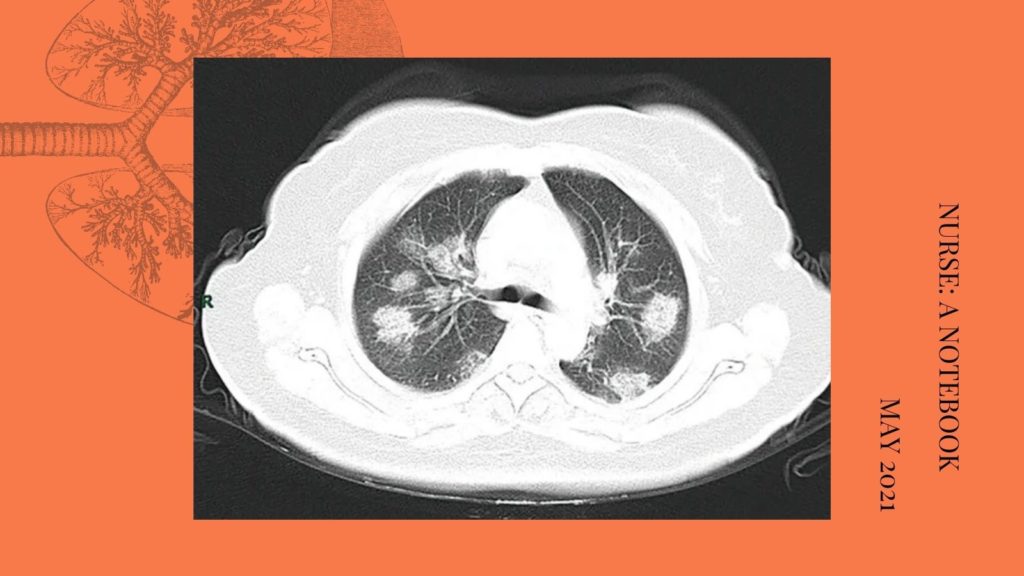How lying down, getting up and marching on Madison Av is a metaphor for the fight vs. tyranny in the Philippines.

June 25, 2018
“Tayo na po kayo. Tayo na po kayo,” said a male voice asking me – actually more like begging me – to get up. I was lying down on my left side on the street pavement of Madison Avenue, somewhere between 29th and 30th Streets.
It was almost 1 in the afternoon, and normally around this time of the year, it would already be summer-hot. But not this year, and definitely not that day, the third day of June. There was a cool pre-summer breeze blowing on and off, and the pavement was surprisingly forgiving.
I opened my eyes and saw that the street was littered with several other people who like me were lying on the ground. Later I would learn that there were around 400 of us. I heard the voice again, this time I knew that it was pleading not just for me, but for all of us to get up and get on our feet; it belonged to a parade marshal.
“Not yet, not yet,” said another voice in Filipino, this time coming from one of the command team members of our delegation.
A full minute passed since we all fell to the ground, word was passed around that it was time for us to rise and resume our march.

Every year since 1990, Filipino Americans in New York and in its larger tri-state area celebrate Philippine Independence Day on the first Sunday of June. The actual date of Philippine Independence Day is June 12, commemorating the day in 1898 when Filipino revolutionaries declared independence from erstwhile colonial master Spain.
The revolution would have been successful; the Philippines would have been a sovereign nation as early as 1898. The revolutionaries have taken control of most of the islands, and were already laying siege to the colonial capital of Manila.
But the rising imperialist power, the United States of America, entered the scene and snatched an almost certain revolutionary victory from the hands of freedom-loving Filipinos. The U.S. came in the guise of helping Filipino revolutionaries overthrow Spanish colonialism, only to turn around and take the Philippines as its own colony.
But that’s for another story. Still, that’s the history that helps explain the long, rocky relationship between the United States and the Philippines, and why there is a large presence of Filipinos in the United States.
That first Sunday of June, a group of Filipinos and Filipino Americans – students, professionals, advocates, artists, writers – led by the Malaya Movement, decided to join the annual Philippine Independence Day Parade not just for sentimental reasons. Yes, we were there to celebrate the 120th anniversary of Philippine Independence. But more than that, we were there to protest the unabated extrajudicial killings in the Philippines, perpetrated by the current President, Rodrigo Duterte.
And for us, the 400, there is no more appropriate way of commemorating Araw ng Kalayaan (Independence Day) than to express our resolve to fight for and defend human and democratic rights in the Philippines and to resist the authoritarian regime of Duterte.

Since Duterte took office in 2016, thousands of people, mostly from poor families and mostly unarmed, have been killed in his now infamous War on Drugs. Hundreds more – political activists, environmentalists, union leaders, peasant organizers and students – have been killed as the culture of impunity grows, where those opposed to the ruling regime were silenced forever.
The actual death toll is hard to ascertain. Some opposition groups in the Philippines place it at around 20,000 people killed from July 2016 to June 2018. Local and international human rights groups, such as Human Rights Watch, estimate the death toll at 12,000 as of January 2018.
But a couple of days before the Independence Day parade, Manny Mogato, the Filipino journalist who was part of the Reuters team that won the Pulitzer Prize for its reports on Duterte’s Drug War, told Filipino journalists here in New York City that using police data, the death count is somewhere in the vicinity of 7,000.
The wide discrepancy in the number of people killed does not mean that the reports of the killings in the Philippines are not true. What it shows is the difficulty of knowing the actual number, since the police have become secretive of its tally due to the growing outrage against the slaughter.
But no one is denying that there have been killings – and there have been thousands of killings. And even if there was only one person killed, that still does not and cannot justify killing unarmed suspected drug users, and even drug dealers, on mere suspicion and without due process. One killing is one too many.
That is why the formation of the Drug Archive Philippines, a research consortium led by three universities in the Philippines and the Center for Investigative Journalism at Columbia University’s Graduate School of Journalism that seeks to come up with a database on drug-related deaths, is a welcome development.
“I thought I am already retired from this,” I said to some of the OGs in the group as we gathered on East 37th Street and waited for our turn to join the parade. I looked around and saw old, familiar faces, people who I have marched with in the past; fellow activists who I have locked arms with many times before, protesting human rights abuses and government corruption in the Philippines, and fellow advocates who I lockstepped with in rallies calling for comprehensive immigration reform here in the U.S.

Many of these OGs were veterans of the contingent who were “escorted out” by the New York Police Department of this same parade in 2005. Back then, we were protesting the tone-deaf and extravagant decision of the then-Philippine Consul General to rent a $10,000-a-month condo at the Trump Tower at a time when the economy of the Philippines was beginning to unravel again.
The organizers, the Philippine Independence Day Committee Inc., or at very least some of its officers who were overzealous in their effort to ingratiate themselves to the Consulate, called the police on us and even asked the police to arrest us – even though we had young children with us at the parade. Such an irony – to be thrown out for exercising your freedom of expression at an event that was supposed to be celebrating your country’s freedom.
I looked around and saw that the Asian American Writers’ Workshop was adequately represented. Poet, journalist and nonfiction writer Luis Francia, former member of the Board of Trustees of the AAWW and author of the book on Philippine history, A History of the Philippines: From Indios Bravos to Filipinos, was holding a placard that reads: “Takot sa babae, takot sa Tsina, hindi lang takot pag kalaban ang mahihirap (Scared of women, scared of China. The only time he is not afraid is when he is fighting the poor).”
The placard refers to Duterte’s proclivity to persecute and exact revenge on women, such as the senator who used to investigate his involvement in the Davao death squad when he was then the mayor of that city; the vice president who ran under a rival party and defeated the son of the late unlamented dictator Ferdinand Marcos, who turns out to be Duterte’s idol; and the Chief Justice of the Philippines who criticized Duterte’s growing dictatorial tendencies.
The sign also takes Duterte to task for his subservience to China. One glaring example is his giving away, willingly, part of Philippine sovereign territory in the West Philippine Sea to China, even though the United Nations Court of Arbitration ruled that the islands in question belong to the Philippines. He also begged China to take the Philippines and make it into one of its provinces. Of course, later, he would say it was just a joke.

And yes, the placard gives credit to Duterte’s bravery – but only when he and his henchmen are shooting down poor, defenseless people who comprise the majority of the fatalities of his Drug War.
Gina Apostol was there, too. The author of Gun Dealers’ Daughter and the newly released Insurrecto, Gina was in the frontline, one of the standard-bearers clutching a long, black tarp that reads: “Resist Duterte’s Fascist Dictatorship! Defend Human Rights and Democracy in the Philippines!”
Other faces in the militant crowd: Fictionist Nita Noveno, who teaches literature at the Borough of Manhattan Community College; Christina Newhard, publisher of Sari-Sari Storybooks that publishes Filipino children’s stories; art editor Carina Evangelista, who brought two wooden signs from Manila, with the faces of Marcos, his son Marcos Jr. and Duterte pasted front and back, and with side clappers that spank the faces when you twirl the handle.; and journalist Cristina Pastor, publisher of TheFilAm.net and vice president of the Filipino American Press Club of New York, who decided that day that she will not cover the event but will express her indignation over what’s happening in the Philippines.
And there were fresh faces, too, young people who are now leading the movement fighting for human rights in the Philippines, and campaigning for immigrant rights here in the United States. With these young aktibistas at the helm, I am at peace and confident that I can remain retired. But the viciousness and brutality happening in the Philippine under the Duterte regime are just too much to ignore.
I feel like I am Michael Corleone in Godfather 3, who, while recovering from a rival family’s hit job, blurted out, “Just when I thought I was out, they pull me back in.” I guess I am just having a delusion of grandeur.
Talk of forming a political, anti-dictatorship group of NYC-based Filipino writers and artists started to float around. Everybody there expressed willingness, and as we say in Filipino, “abangan ang susunod na kabanata (watch out for the next chapter).”
And then it was time to march. From 37th Street, we turned left on Madison Avenue, to join all the other contingents who were giving their best performances, dancing their way to the grand viewing station, somewhere between 29th and 30th Streets, where officials of the Philippine Consulate General-New York sat and watched the diverse performances.

Almost all of the contingents were dancing all throughout the parade. Us? Of course we can dance, too. But that is not what we went there for. We were there to expose and oppose the unbridled killings and the rising fascism in the Philippines. Words from Wole Soyinka, the Nigerian novelist, poet and 1986 Nobel Prize for Literature awardee, comes to mind: “The greatest threat to freedom is the absence of criticism.”
Along the way, we were chanting:
“Never again, never again, never again to Martial Law,” referring to the declaration of Martial Law and suspension of democratic rights in the southern island of Mindanao, and Duterte’s threat to put the entire nation under martial law, just like his idol Marcos did.
“Marcos, Duterte, walang pinag-iba! Parehong tuta, diktador, pasista (Marcos, Duterte, there is no difference! Both are puppets, dictators, fascists),” said one chant likening Duterte to Marcos.
“No justice, no peace! Stop the killings in the Philippines.”
Of course, despots who cultivate populist image tend to attract supporters from some sectors of the populace. There were those who were booing us as we chant, giving us the thumbs-down sign. I guess the philosopher Sophocles was right when he said: “No one loves the messenger who brings bad news.”
A contingent of Duterte die-hards behind us even tried to drown our voices, but to no avail. They cannot out-chant us, no way. We have been doing this for years, even decades now, and we have become good at it.
But there are also those who cheered us as soon as they saw our banners and as soon as they heard our chants. They gave us two thumbs-up and not a few started chanting with us. Yes, they knew our slogans. “Ang tao, ang bayan, ngayon ay lumalaban (The people, the nation, they now are fighting back)!”
As soon as we reach the viewing stand, the Duterte effigy that the group was carrying in front of the delegation made a 180-degree turn to reveal an automatic rifle. That was the cue. That was the signal for us to fall to the ground and stage the die-in.

Four hundred people sprawled on the ground, pretending to be dead to symbolize the 7,000, or 12,000, or 20,000 people killed in the murderous onslaught by the Duterte death squad. It’s not even a tenth of the total number of people killed by the two-year-old Duterte regime. But maybe that is enough for people to visualize the magnitude of the killings.
“Twelve thousand,” a voice, coming from one of those on the ground, shouted out, referring to the estimates of the fatalities of Duterte’s Drug War.
“And counting…” another voice chimed in.
When the command to get up was issued, I stayed down for a while before making any attempt to rise. When you’re of a certain age, it’s not easy anymore to fold and unfold, to bend and unbend. When you also think of the journey still ahead of you, sometimes it’s too easy to get tempted to just stay down and forget about the march.
But we got up, stood up and resumed our march, everybody convinced that ours is an unfinished journey to reach the goal that we have set to accomplish. Being down and rising up to continue the march is a metaphor for the people’s long march towards freedom from tyranny.




